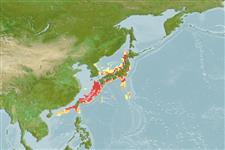Environment: milieu / climate zone / depth range / distribution range
Οικολογία
Θαλασσινό(ά) βαθύβιο(ς); ωκεανόδρομο(ς) (Ref. 51243); εύρος βάθους 320 - 830 m (Ref. 54340). Temperate; 46°N - 19°N, 113°E - 143°E (Ref. 54340)
Northwest Pacific: Japan, Korean Peninsula and the East China Sea.
Μέγεθος / Βάρος / Age
Maturity: Lm ? range ? - ? cm
Max length : 100.0 cm TL αρσενικό/απροσδιόριστο; (Ref. 559); μεγ. αναφερόμενη ηλικία: 8 έτη (Ref. 72462)
Short description
Κλείδες προσδιορισμού | Μορφολογία | Μορφομετρία
Σπόνδυλοι: 142 - 148. Head and body with white spots. Lower jaw moderate in size, premaxillary teeth not exposed when closed. Upper lip groove deep (appearing folded up). Maxillary teeth arranged in almost 1 row. Preanal lateral line pores 39-43 (Ref. 41299).
Common on coasts of Japan, in sandy-muddy bottoms (also Ref. 11230); most relished among the congrids. Captured and cultured for fishery in Japan.
Life cycle and mating behavior
Γεννητική Ωρίμανση | Αναπαραγωγή | Γεννοβολία | Αβγά | Γονιμότητα | Προνύμφες
Masuda, H., K. Amaoka, C. Araga, T. Uyeno and T. Yoshino, 1984. The fishes of the Japanese Archipelago. Vol. 1. Tokai University Press, Tokyo, Japan. 437 p. (text). (Ref. 559)
IUCN Red List Status (Ref. 130435: Version 2024-1)
Threat to humans
Harmless
Human uses
αλιεία: πολύ εμπορικό; αλιεία αναψυχής: ναί
Εργαλεία
Special reports
Download XML
Διαδικτυακές πηγές
Estimates based on models
Preferred temperature (Ref.
123201): 0.5 - 13.5, mean 8.8 °C (based on 41 cells).
Phylogenetic diversity index (Ref.
82804): PD
50 = 0.5000 [Uniqueness, from 0.5 = low to 2.0 = high].
Bayesian length-weight: a=0.00059 (0.00039 - 0.00090), b=3.23 (3.11 - 3.35), in cm total length, based on LWR estimates for this species & Genus-body shape (Ref.
93245).
Τροφικό Επίπεδο (Ref.
69278): 4.0 ±0.68 se; based on food items.
Generation time: 5.8 ( na - na) years. Estimated as median ln(3)/K based on 1
growth studies.
Ελαστικότητα (Ref.
120179): Μεσαίο(α), ελάχιστος χρόνος για διπλασιασμό πληθυσμού 1,4 - 4,4 έτη (Assuming tm>4).
Prior r = 0.51, 95% CL = 0.33 - 0.76, Based on 1 data-limited stock assessment.
Fishing Vulnerability (Ref.
59153): Moderate to high vulnerability (53 of 100).
Climate Vulnerability (Ref.
125649): High to very high vulnerability (73 of 100).
Nutrients (Ref.
124155): Calcium = 23.4 [14.3, 41.7] mg/100g; Iron = 0.299 [0.176, 0.494] mg/100g; Protein = 18.2 [15.4, 21.0] %; Omega3 = 0.6 [0.3, 1.6] g/100g; Selenium = 27.9 [15.5, 51.1] μg/100g; VitaminA = 8.56 [2.37, 30.98] μg/100g; Zinc = 0.377 [0.277, 0.529] mg/100g (wet weight);
